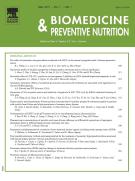Protective effect of curcumin on chloroform as by-product of water chlorination induced cardiotoxicity - 30/05/14

Abstract |
Chloroform (CHCl3) is one of the volatile organic compounds detected most frequently in both ground and surface water. This study aimed to evaluate the efficacy of curcumin (CMN) to attenuate CHCl3 toxicity and cellular dysfunction in cardiac tissue of female albino rats. Fifty rats were divided into 5 groups, 1st group was control; 2nd group rats were intoxicated with 150mg CHCl3/kg BW; 3rd group rats were treated with 50mg CMN/kg BW; 4th group rats were treated with 50mg CMN/kg BW for 30 days then intoxicated with 150mg CHCl3/kg BW for 60 days and 5th group rats were intoxicated with 150mg CHCl3/kg BW plus 50mg CMN/kg BW, respectively. Treatment was continued for 90 days. The levels of lipid peroxidation, myeloperoxidase (MPO) and xanthine oxidase (XO) were increased and the activities of antioxidant enzymes, protein content and endogenous antioxidants were decreased in cardiac tissues in rats treated with CHCl3 in comparison with control group. Serum cholesterol, triglycerides and LDL-C levels were increased while high HDL-C was decreased in rats treated with CHCl3 in comparison with control group. Treatment with CMN helps in improving the adverse effect of CHCl3 toxicity; also our histological results confirm this finding. The present study could be concluded that CMN has protective and ameliorative effects against CHCl3 induced oxidative stress.
Le texte complet de cet article est disponible en PDF.Keywords : Chloroform, Curcumin, Heart, Antioxidant enzymes, Cardiac toxicity
Plan
Vol 4 - N° 2
P. 225-230 - avril 2014 Retour au numéroBienvenue sur EM-consulte, la référence des professionnels de santé.
L’accès au texte intégral de cet article nécessite un abonnement.
Déjà abonné à cette revue ?

